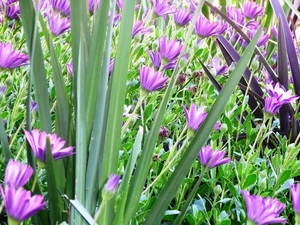The best word to sum up the cottage garden is ‘informal’ or ‘unsophisticated’. It is a style in which a random mix of plants is grown.
Look for self seeding varieties of annuals and biennials that will pop up wherever they like, creating color combinations that change each year, and team them with a range of perennials that grow to different heights.
The garden in which they grow will have a small-scale, purely functional framework, without any grand vistas or extravagant hard landscaping.
In a cottage garden the trees should, whenever possible, be fruit trees or at least blossom trees of some kind. Apples, pears, plums and cherries will all help to create the right atmosphere, as will nut trees. If there is a space for a large tree, a walnut would be an ideal choice.
Colorful plants, or perhaps herbs, in simple pots by the door will look appropriate. Make the most of vegetable and fruit bushes, letting them be part of the garden design. Do not be afraid of using rows of vegetables, herbs, climbers, bedding plants or flowers for cutting, especially alongside a path.
There is no need to grow only old-fashioned flowers because it is how the flowers are used and grouped that creates the cottage style, not the type they are. Choose as many scented plants as can be fitted into the space available, especially from among the many varieties of climbing rose and honeysuckle. Roses and flowering shrubs will provide a framework for the other less permanent plants.
The overall effect should be well-tended ‘disorder’, a comfortable mix in which all the plants are allowed to run together. Situate the plant close together to create an overcrowded, lush effect, and keep weeds down until plants take off. This is a great opportunity to grow all your favorite plants in rich profusion.
The epitome of a cottage garden is a profusion of scented roses, lilacs and lilies mingled with bright flowers and the foliage of herbs that are both ornamental and useful.
Create a cottage garden instead of a front-yard lawn, or next to a garage of fence; anywhere you will see and enjoy it frequently. All these flowers require is full sun and rich, well-drained soil.
Here are a few varieties of suitable cottage garden plants to get you started:
The climbing Rose ‘Danse du feu’ has a height and spread of 2.5 meters and produces a profusion of red blooms in summer. It is ideal for growing along a fence, arbor, or trellis.
Potentilla is a good edging shrub which produces gold flowers all summer long. It sports dark green compound leaves and is drought tolerant growing from 30 cm to 1.2 meters tall and 60 cm to 1.2 meters wide.
Delphiniums add colorful height to the cottage garden, reaching to nearly 2 meters. Their green leaves and deeply cut and their flower spikes come in shades of blue, lilac or white which show in early summer.
The biennial Sweet William, freely self seeds and has green lance like leaves and produces fragrant pink, red or white flowers.
California poppies are fast growing annuals with slender, blue-green foliage; showy poppy flowers in colors from cream to bronze and orange.
White Alyssum is another fast growing annual with fine, deep green foliage, masses of circular white flower heads and will self seed.
Perennial Coneflowers grow to nearly a meter tall and stand upright with clumps of mid-green, arrow-shaped foliage. Their tall stems are topped by rosy purple flowers with dark centers.
Tall Foxgloves form clumps of dull green foliage and produce tall flower spikes with cream and mauve bell-shaped blooms.
Enjoy the informal mass of easy-to-grow colorful blooms and bask in its casual, country charm.
